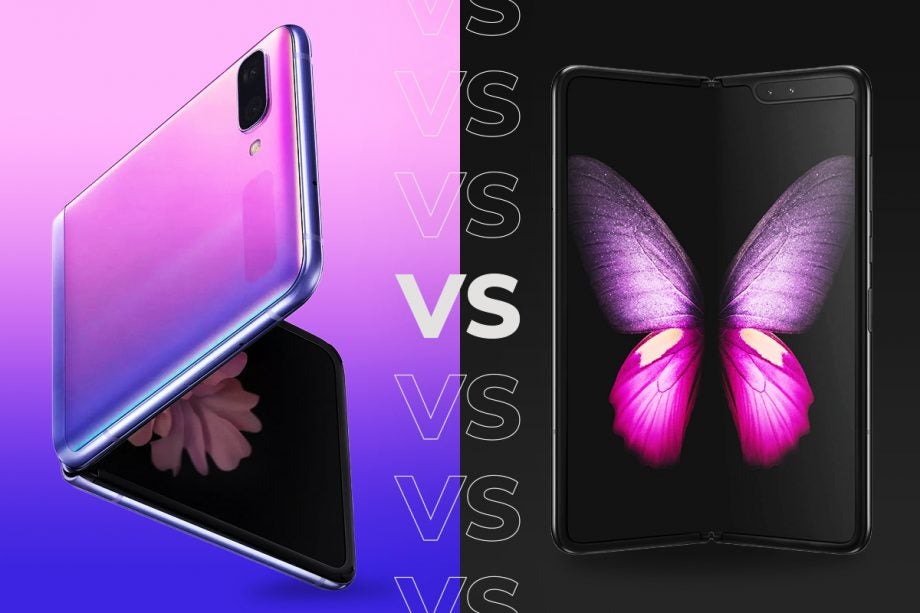Samsung Galaxy Z Flip vs Samsung Galaxy Fold: The foremost foldables?

How does Samsung’s newest foldable compare with its first foray with the radical redesign? We compare the specs to find out which one is top dog.
When the Galaxy Fold was unveiled for the first time, the thrill of innovation quickly gave way to horror as the device easily malfunctioned when treated indelicately. Its release date was delayed and the product was re-released to greater success, but we still weren’t completely won over in our review. Has the Galaxy Z Flip perfected the foldable concept at Samsung’s second attempt?
Samsung Galaxy Z Flip vs Samsung Galaxy Fold: At a glance
- The Samsung Galaxy Fold was the first mainstream foldable phone to be released. Teething problems due to its vulnerable screen delayed its launch, which finally took place in September 2019.
- We gave the device 3/5 stars, noting that the larger tablet-like screen is useful in some circumstances but could also feel clunky and delicate, while the camera isn’t the very best around.
- Samsung Galaxy Z Flip is Samsung’s second attempt at a foldable phone, and it adopts a new form factor reminiscent of a flip phone, similar to the Motorola Razr.
- The Z Flip is a lot more compact than its predecessor, and this time round the screen is made of Ultra Thin Glass rather than plastic.
Samsung Galaxy Z Flip vs Samsung Galaxy Fold: Specs and Camera
First off, the Samsung Galaxy Fold. It packs the powerful specifications you’d expect of a top-end 2019 smartphone, with the key selling point of that distinctive design.
- Price: £1900 ($1980)
- Main Screen: 7.3-inch AMOLED, 1536 x 2152p resolution
- Processor: Snapdragon 855
- Memory: 12GB RAM, 512GB storage
- Battery: 4380mAh
- 5G
The Samsung Galaxy Z Flip is notably smaller than the Galaxy Fold, so its screen isn’t as big and its battery capacity isn’t as large. Yet it does boast a souped-up version of the Fold’s chipset.
- Price: £1300 ($1380)
- Main Screen: 6.7-inch AMOLED, 1080 x 2636 resolution
- Processor: Snapdragon 855 Plus
- Memory: 8GB RAM, 256GB storage
- Battery: 3300mAh
- 4G
The Galaxy Fold has a total of six camera sensors, double the count on the Galaxy Z Flip. Firstly the main camera module includes a 12-megapixel main sensor, a 16-megapixel ultrawide lens, and a 12-megapixel telephoto sensor. The selfie set-up consists of a 12-megapixel main camera and an 8-megapixel depth sensor, while there’s an additional cover camera that’s got a 10-megapixel resolution.
By contrast, the Z Flip has three cameras in total; a 10-megapixel selfie camera, which is found in a cutout in the screen, and dual 12-megapixel sensors on the outer casing, fitted with wide and ultrawide lenses. As far as the camera is concerned, the Galaxy Fold clearly has more firepower than the Z Flip – but we’ve yet to directly compare their performances.
Samsung Galaxy Z Flip vs Samsung Galaxy Fold: Battery and Charging
The Samsung Galaxy Fold has a chunky 4380mAh battery, and in our time reviewing the handset we found the battery life to be great – despite our initial reservations about the fact that it had to power two screens, we found ourselves with 20% to 30% of battery life left over after a heavy day’s usage. When it comes to charging back up again, the device supports 15W charging, both wired and wireless, and is also capable of 9W reverse wireless charging.
We have less hands-on experience of the Galaxy Z Flip, but nonetheless it offers a decent 3300mAh battery, rechargeable by 15W wired charging, and capable of charging wirelessly too.
Samsung Galaxy Z Flip vs Samsung Galaxy Fold: Look and feel
The Samsung Galaxy Fold was the first mainstream foldable phone to hit shop shelves, and so naturally it ushered in a distinctive new from factor. It appears somewhat like a book, with a thick cover housing a small secondary screen (4.6-inches), which can then open up along a vertical axis to reveal a tablet-sized 7.3-inch screen.
The Galaxy Z Flip, by comparison, seems to take notes from the Motorola Razr design, which harks back to the popular flip phones of the noughties. This device has a more typical 6.7-inch screen, but the outer screen is even smaller, at just 1.1-inches.
Your preference in this area simply comes down to taste – do you want a big-screen tablet experience or a more compact version of your current phone?
Samsung Galaxy Z Flip vs Samsung Galaxy Fold: How much do they cost?
You’re not going to get either of these for a bargain price – be prepared to drop some serious cash. The Samsung Galaxy Fold costs £1900 ($1980), an incredibly high amount for a smartphone by anyone’s standards.
In comparison the Galaxy Z Flip costs £1300 ($1380), meaning that it’s the cheaper option, but nonetheless a massive outlay for a smartphone – an amount that could get a top performing flagship with plenty of cash still to spare.
The main selling point of both devices is the form factor, so you’ve got to consider whether that’s worth paying those big bucks for.
Samsung Galaxy Z Flip vs Samsung Galaxy Fold: Initial thoughts
Both of these handsets have high specifications – but very high prices too. The main factor you’ll have to consider if you’re choosing between the two is what form factor you prefer. If you’re seeking a tablet-sized screen then the Galaxy Fold is probably best suited, but if you want a compact, flip phone throwback then the Galaxy Z Flip looks to be your best bet from Samsung.


